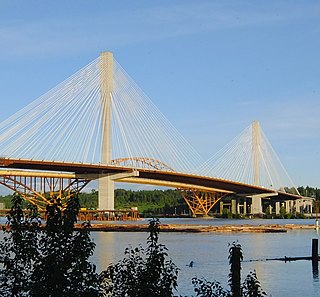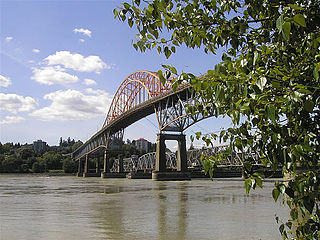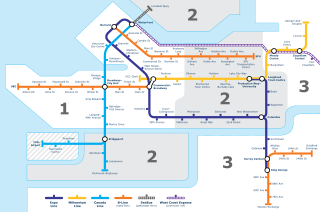
Volkswagen is a German automobile manufacturer based in Wolfsburg, Lower Saxony, Germany. Established in 1937 by the German Labour Front under the Nazi Party, it was revitalized into the global brand it is today after World War II by British Army officer Ivan Hirst. The company is well known for its iconic Beetle and serves as the flagship marque of the Volkswagen Group, which became the world's largest automotive manufacturer by global sales in 2016 and 2017.

SkyTrain is the medium-capacity rapid transit system serving the Metro Vancouver region in British Columbia, Canada. SkyTrain has 79.6 km (49.5 mi) of track and uses fully automated trains on grade-separated tracks running on underground and elevated guideways, allowing SkyTrain to hold consistently high on-time reliability. In 2023, the system had a ridership of 141,339,300, or about 456,300 per weekday as of the second quarter of 2024.

The Volkswagen Golf is a compact car/small family car (C-segment) produced by the German automotive manufacturer Volkswagen since 1974, marketed worldwide across eight generations, in various body configurations and under various nameplates – including as the Volkswagen Rabbit in the United States and Canada, and as the Volkswagen Caribe in Mexico (Mk1).

TransLink, formally the South Coast British Columbia Transportation Authority and previously the Greater Vancouver Transportation Authority, is the statutory authority responsible for the regional transportation network of Metro Vancouver in British Columbia, Canada, including public transport, major roads and bridges. Its main operating facilities are located in the city of New Westminster.

The Canada Line is a rapid transit line in Greater Vancouver, British Columbia, Canada, that is part of the SkyTrain system. The line is owned by TransLink and InTransitBC and is operated by ProTrans BC. Coloured turquoise on route maps, it operates as an airport rail link between Vancouver, Richmond, and the Vancouver International Airport (YVR). The line comprises 16 stations and 19.2 kilometres (11.9 mi) of track; the main line runs from Vancouver to Richmond while a 4-kilometre (2.5 mi) spur line from Bridgeport station connects to the airport. It opened on August 17, 2009, ahead of the 2010 Winter Olympics.

The Ironworkers Memorial Second Narrows Crossing, also called the Ironworkers Memorial Bridge and Second Narrows Bridge, is the second bridge constructed at the Second (east) Narrows of Burrard Inlet in Vancouver, British Columbia, Canada. Originally named the Second Narrows Bridge, it connects Vancouver to the North Shore of Burrard Inlet, which includes the District of North Vancouver, the City of North Vancouver, and West Vancouver. It was constructed adjacent to the older Second Narrows Bridge, which is now exclusively a rail bridge. Its construction, from 1956 to 1960, was marred by a multi-death collapse on June 17, 1958. The First Narrows Bridge, better known as Lions Gate Bridge, crosses Burrard Inlet about 8 kilometres (5.0 mi) west of the Second Narrows.

The Golden Ears Bridge is a six-lane extradosed bridge in Metro Vancouver, British Columbia. It spans the Fraser River, connecting Langley on the south side with Pitt Meadows and Maple Ridge on the north side. The bridge opened to traffic on June 16, 2009. The bridge replaced a previous ferry service several kilometers upstream and will be run by a private consortium, the Golden Crossing General Partnership, until June 2041.

The Cambie Bridge is a six-lane, precast, box girder bridge spanning False Creek in Vancouver, British Columbia. The current bridge opened in 1985, but is the third bridge at the same location. Often referred to as the Cambie Street Bridge, it connects Cambie Street on the south shore of False Creek to both Nelson and Smithe Streets in the downtown peninsula. It is the easternmost of False Creek's fixed crossings; the Burrard and Granville bridges are a little more than a kilometre to the west, and the new Canada Line SkyTrain tunnel is built just west of the Cambie Bridge.

The Port Mann Bridge is a 10-lane cable-stayed bridge, 90 km/h speed limit, in British Columbia, Canada, that opened to traffic in 2012. It carries 10 lanes of traffic with space reserved for a light rail line.

The Pattullo Bridge is a through arch bridge that crosses the Fraser River and links the cities of New Westminster and Surrey in Metro Vancouver, British Columbia. It was named in honour of Thomas Dufferin Pattullo, the 22nd Premier of British Columbia. A key link between Surrey and the rest of Greater Vancouver, the Pattullo Bridge handles an average of 75,700 cars and 3840 trucks daily, or roughly 20% of vehicle traffic across the Fraser River as of 2013.

Transportation in Vancouver, British Columbia, has many of the features of modern cities worldwide. Unlike many large metropolises, Vancouver has no freeways into or through the downtown area. A proposed freeway through the downtown was rejected in the 1960s by a coalition of citizens, community leaders and planners. This event "signalled the emergence of a new concept of the urban landscape" and has been a consistent element of the city's planning ever since.

The Volkswagen Golf Mk5 is a compact car/small family car manufactured and marketed by Volkswagen, as the fifth generation of the Golf in three- or five-door hatchback and a five-door station wagon (2007–2009) configurations, as well as the successor to the Golf Mk4. Using the Volkswagen Group A5 (PQ35) platform, the Mk5 debuted at the Frankfurt Motor Show in October 2003 and went on sale in Europe for the 2004 model year. While marketed as the Volkswagen Rabbit in the United States and Canada, the GTI model in these countries was marketed simply as the Volkswagen GTI.

Rebecca Belmore is a Canadian interdisciplinary Anishinaabekwe artist who is notable for politically conscious and socially aware performance and installation work. She is Ojibwe and a member of Obishikokaang. Belmore currently lives in Toronto, Ontario.
Konstantin Dimopoulos is a social and environmental artist whose art practice is grounded in his sociological and humanist philosophies. He investigates globally relevant questions related to ecology and the human condition through his socio-environmental interventions and conceptual proposals, which argue for the potential of art as a means of social engagement and change. He is known for large public kinetic sculpture, The Blue Tree - an art installation about deforestation and Purple Rain - a textual and visual response to homelessness.

The Volkswagen Golf (Mk7) is a C-segment car manufactured by German automobile manufacturer Volkswagen. It is the seventh generation in the Golf series and the successor to the Golf Mk6, and was introduced in Berlin on 4 September 2012, before a public launch at the 2012 Paris Motor Show. Sales in Europe began with the model in November 2012.

Beau Dick was a Kwakwaka'wakw Northwest Coast artist and Chief who lived and worked in Alert Bay, British Columbia, Canada. He was a contemporary artist, activist and hereditary Chief from the Namgis First Nation. Dick was an artist with an extensive national and international exhibition history. Beau Dick.
Transportation Investment Corporation is a public Canadian crown corporation, established in 2008 under the Transportation Investment Act, to implement the Port Mann/Highway 1 Improvement Project, including construction, operations and maintenance of 37 kilometres (23 mi) of improvements to the TransCanada Highway through Metro Vancouver, as well as development, implementation and management of tolling operations to pay for the project. Starting September 1, 2017, the crown corporation stopped tolling traffic on the bridge, due to a new provincial government. Debt service was transferred to the province of British Columbia at a cost of $135 million per year.

Freezing Water Number 7 was a stainless steel sculpture by Chinese artist Ren Jun. It was erected in Vancouver, British Columbia's Vanier Park in 2009, just prior to the 2010 Winter Olympics, for the 2009–2011 Vancouver Biennale. The installation marked Jun's North American debut.

Marianne Nicolson is a Dzawada’enuxw visual artist whose work explores the margins at which public access to First Nations artifacts clashes with the preservation of indigenous cultural knowledge. She utilizes painting, photography, mixed-media, sculpture, and installation to create modern depictions of traditional Kwakwaka’wakw beliefs, and has exhibited in Canada and throughout the world since 1992.
Ron Tran is a visual artist based in Vancouver, British Columbia.


















